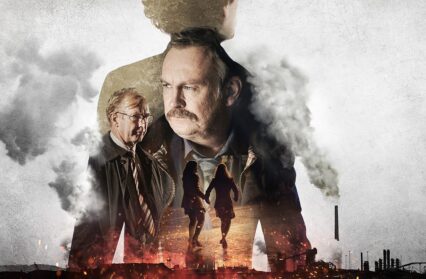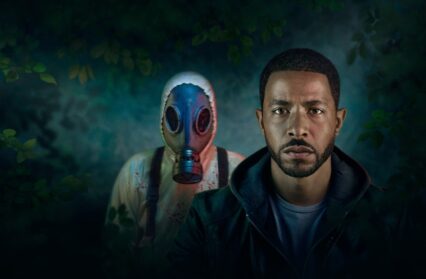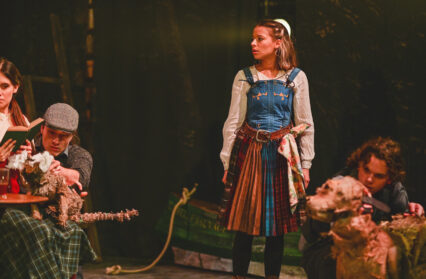Gary Raymond ponders a ricocheting narrative and an on-form cast in a look at recent TV drama Steeltown Murders.
Filming the past can present a director with a whole range of challenges, and the most important ones are conceptual. On television this last month “period” detective dramas have drawn stark lines about how these concepts might take form in different ways. At home in Wales, 70s hardman Londoner (in Life on Mars, at least) Philip Glenister has come over the Prince of Wales Bridge to don accent, overcoat, and moustache to give a turn as Paul Bethell, a police detective with the weight of the world on his shoulders. In Steeltown Murders we learn that weight is the result of a spate of unsolved murders from, as it happens, the 1970s, in the Port Talbot area. Here the creators have two periods to wrestle with. And if you thought that the wigs and sideburns of the 70s would act as a perfectly fine marker for which era we are in, you’d be mistaken, because Bethell (rather like my dad) had kept his moustache all along. We need more signifiers. Glenister wakes up one morning and David Gray’s “Babylon” is playing on the radio. A quick Google reminds me that that song came out in 1999, so here we are at the turn of the millennium (I think my dad got rid of his moustache early in the new century). There is more music to let us know we are in the 70s when we are back in the 70s, accompanying the flares and tank tops and sideburns and moustaches. Although at one point, Nia Roberts, playing Bethell’s wife, seems retro-fitted for the 70s when it’s supposed to be 1999. A timeslip? But there’s enough to be thinking about connecting the actors to the roles across the time-divide to be wondering if Roberts has walked into the wrong decade. The creators soon decide that giving all 70s’ scenes an amber hue is the best way to make the eras clearly defined. It is a help in a ricochet narrative.
It wouldn’t matter so much was this not a true story, and the murdered victims at the periphery of this story of police doggedness were fighting for attention in a complex set of temporal strands. Steeltown Murders does a decent job at juggling a lot of balls. The acting is strong, the tone is gloomy, and the script is sombre and to the point (although I’m not sure a police chief would say that case is being reopened because of “the scientists”).
The other televisual delight is more courtroom drama than straight-up detective show, but lawyer Perry Mason has always been a variation on a theme, both in the original novels by Earl Stanley Gardner, and then in the hit TV series with the adamantine Raymond Burr in the title role. Burr was clean cut and steely eyed, every courtroom he stood in was part Roman amphitheatre and one-hundred-percent 1950s American television set. Matthew Rhys’s Mason is a darker figure, swamped in demons (but not the tedious kind), and gasping for air. Rhys, a fine actor, may very well be in the second season of his career-best performance. The world around him is a deliciously realised Los Angeles of the 1930s, but rather than the Raymond Chandler L.A., or even the Polanski L.A. of Chinatown, we are treated to something very much with its own flavour. This is the L.A. of Earl Stanley Gardner, perhaps, full of heavy golden sunsets and hard grey roads. There are sweat patches and smoke rings and nobody seems truly comfortable as they go about their days. This is the sort of town where funding decent air conditioning could be the motivation for some of the greatest crimes. We are witnessing a civilisation in the earliest stages of its ragged collapse, and the makers of this Perry Mason reboot seem to have been very aware of what they might be tapping into with this source material. We are decades away from the Chinatown’s waterboard corruption, and from Rodney King, and the murders of Nicole Brown and Ron Goldman, but decades in TV count for little, especially when entire eras can be connected by the simple donning of a moustache.
Rhys is perhaps now Wales’s greatest export, at least in theatrical terms. The layers and depth he brings to a character like Mason is that rare thing in this age of reboots and re-imaginings: he makes Mason his own. Perry Mason is without doubt a man of his age, damaged by war, disillusioned with the direction of travel of the American civic dream – but he is also resolutely contemporary; and it is Rhys who brings this to us, dancing around a great script and a story unafraid to take its time.
Steeltown Murders is available to watch now on BBC iPlayer.



 Enjoyed this article? Support our writers directly by buying them a coffee and clicking this link.
Enjoyed this article? Support our writers directly by buying them a coffee and clicking this link.







